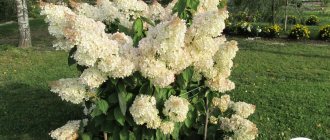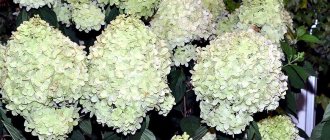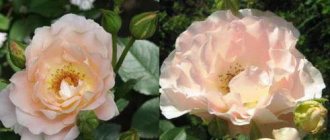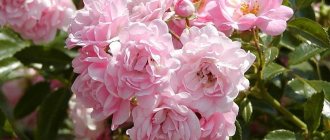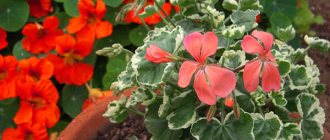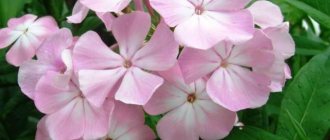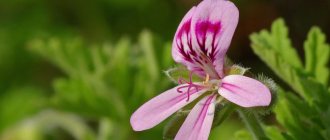It is not for nothing that the rose is called the “queen of the garden”, because its buds are captivating, its aroma is attractive, and its color palette delights. But before you decide to plant it, you need to study all the nuances of growing it. First of all, you need to pay attention to suitable conditions, because not all varieties can take root in a changeable climate. This is exactly how you can describe the weather in the Moscow region. But thanks to the work of breeders, today there are varieties that successfully adapt to such harsh conditions. In addition, it is possible to choose park roses without shelter for the Moscow region, hardy and resistant to many adverse factors.
Park roses are one of the most suitable varieties for growing in central Russia, including in the Moscow region
Criteria for choosing park roses for the Moscow region
There are no special criteria for choosing park roses for the Moscow region; as a rule, these are only purely individual preferences. But any gardener pays attention to the budding of the plant. And the earlier and longer the bush blooms, the more popular the variety. In addition, many take into account versatility, so that the range of shades pleases not only the eye, but also matches the style direction of the garden. No less important are frost and drought resistance, as well as immunity to diseases and pests.
How to choose the right seedlings for the Moscow region
When purchasing rose seedlings for the Moscow region, you need to pay attention to several criteria:
- Frost resistance. The shrub must tolerate cold temperatures of at least -25 ° C without shelter or with minimal insulation.
- Endurance. It is desirable that the pink variety can easily withstand drought and prolonged rains - the weather in the summer in the Moscow region can be changeable.
- High immunity. The plant should not be susceptible to fungal diseases and viruses, otherwise care will become very difficult.
Otherwise, when choosing, they are guided by their own preferences. The rose must have a height suitable for planting in a particular place. In addition, you need to make sure that it will harmoniously combine with neighboring plants in color.
The best park roses for the Moscow region
Unfortunately, not all varieties of prickly beauty are suitable for growing in the Moscow region, where winters are quite harsh and summers are not always warm. Basically, gardeners try to choose species of Canadian and English selection; they are more resistant to temperature changes. But don’t discount French and German hybrids, which are also able to survive a frosty winter.
Leonardo da Vinci
The park rose Leonardo da Vinci is the brainchild of the French breeder Alain Meillan. In the conditions of the Moscow region, it grows very compactly, its size can vary between 0.6-1.5 m. Despite this, the bush is quite dense, with powerful leaves and strong, erect shoots. The flowers are large (7-10 cm in diameter), goblet-shaped, classic in shape. The tone of the petals is soft pink. The aroma is subtle, with notes of fruit.
Attention! Bushes of this variety can easily withstand frosts down to -20 °C; at lower temperatures it is better to cover the rose for the winter.
The Leonardo da Vinci rose is valued for the fact that the decorative appearance of the buds does not suffer from sudden gusts of wind and precipitation
Rose Lions Rose
The rose variety Lions Rose is a creation of the German company Kordes, which is part of the “Fairytale Roses” collection. The bush is medium-sized, reaches a height of up to 90 cm. The shoots are straight, long, with large flowers up to 10 cm in diameter at the ends. The buds are double, when half-opened, they have a creamy-pinkish tint with an apricot core. When fully opened, the flowers acquire a beige color. The aroma is unobtrusive, sweet.
The Lions Rose variety is characterized by abundant and long-lasting (wavy) flowering until frost.
Louis Odier
The park rose Louis Odier was created by the French breeder Jamesin Odier, working at the Bellevue nursery. Later, the rights to distribute the variety were purchased by Margotin (England).
The bush is tall, up to 130 cm, densely leafy and prickly. The rose blooms in waves. Its buds initially resemble a peony; when fully bloomed, they take on a cup-shaped shape. The color is darker pink towards the core and fades towards the edges. The aroma is attractive, with a slight hint of citrus.
Large flowers can appear on clusters of up to five pieces, causing the shoots to bend, creating the impression of a blooming fountain
Features of the variety
Experienced flower growers know that caring for ornamental plants takes a lot of time and effort. In addition, not all flowers are able to survive in harsh climates. Canadian breeders have developed varieties of roses that are resistant not only to cold weather, but also to powdery mildew. Here are their main advantages:
- long flowering period;
- pleasant but unobtrusive aroma;
- ability to propagate by cuttings;
- no difficulties in care;
- the ability to plant in open ground, even in cold regions;
- well suited for creating hedges.
Pink Canadian
In addition, the Canadian rose does not require additional shelter during cold weather. The flower has a double or semi-double texture. There are buds in white, pink, red, cream and salmon shades.
Attention! In the descriptions of nurseries, the Canadian rose is called unpretentious and resistant to cold. Of course, success largely depends on the specific site and microclimate of the region.
The seedlings feel great even in northern latitudes. These flowers can decorate any garden.
Frost resistance
Canadian rose, as a rule, looks more modest than other varieties, but can withstand even 30-degree frost. This flower really does not require covering from spunbond or spruce branches. The flowering period begins in the first days of summer and ends with the onset of the first frost.
In the first winter, to be on the safe side, it is necessary to cover the base of the bush with sand and earth in equal parts.
Lush flowering
Roses of Canadian selection are resistant to weather changes. They are able to bloom luxuriantly all summer. The leaves of the plant are rich green. The variety of shades and small number of thorns have made these varieties popular among florists and decorators. Flowering can continue until frost. Its start depends on the region.
Note! Canadian roses have two waves of flowering. The second lasts less. However, the flowering is not so abundant.
Recovery after frost
Breeders from Canada have long worked to develop roses that can withstand extreme cold. As a result, scientists have discovered flowers with excellent regenerative abilities. Rapid recovery after cold weather is inherent in the genotype of the plant. If the crown freezes completely, branches can grow back from renewal buds on the roots.
Disease resistance
Canadian roses are an excellent solution for novice gardeners and those who do not want to spend a lot of time caring for their flower beds. This unpretentious plant is famous for its increased resistance to disease.
Some varieties of Canadian roses are often attacked by pests, most often the green rose aphid. For prevention purposes, it is necessary to treat the plant with systemic or contact insecticides.
Growing is quite simple
The best varieties of park roses without shelter for the Moscow region
Despite the unpretentiousness and winter hardiness of the varieties described above, they still require preliminary preparation for winter. But there are also more frost-resistant options for park roses for the Moscow region, photos with names of which are presented below.
Westerland
The park rose Westerland from the German company Kordes is highly resistant to frost, which is important when grown in the Moscow region. It also has good immunity to powdery mildew and black spot.
The bush is tall, reaching up to 2 m. The shoots are flexible and powerful, easily supporting 5-10 buds. The leaves are glossy, light green in color. The buds when closed have a dark orange tint; as they open, their color changes to a lighter, peach color. The flowers are large, 10-11 cm in diameter and have a pleasant rich aroma.
One of the features of the Westerland park rose is its heady, persistent aroma.
Chippendale
The rose variety Chippendale (Chippendale) of German selection belongs to the park variety due to its vigorous growth. The declared height of the bush varies from 70 to 120 cm, while the width reaches up to 100 cm.
Flowering is abundant, wavy. Up to three buds can form on one shoot. The flowers are large, about 12 cm in diameter. Their shape is rounded-ovoid, tapering towards the apex. The colors are interesting, changing as the buds bloom. At first they have a bright orange hue, then the petals fade and acquire a delicate peach color.
Without shelter, the Chippendale park rose can withstand frosts down to - 28 °C
Chinatown
The Chinatown rose variety is also classified as a park variety that does not require shelter when grown in the Moscow region. The bush is tall (185 cm in height) and quickly growing, can reach up to 120 cm in width.
The buds are bright, creamy yellow, with slightly noticeable pink streaks. The shape is goblet-shaped, in full bloom it is cup-shaped, consists of 25-35 densely collected petals. The diameter of the flower varies from 7 to 10 cm. The aroma is rich, fruity.
Park rose Chinatown takes root well in partial shade and tolerates cool summers well.
Augusta Louise
This sophisticated rose is considered a true artist. She amazes with her grace and beauty. Lush bushes delight with flowering right up to frost, and cut buds are perfectly stored.
This variety was developed in Germany in 1999. She received many different awards at international exhibitions. The bush is well branched and dense, can reach a height of 120 centimeters. Flowering occurs almost continuously; it includes three waves, with the first and second having the greatest intensity. The third is not as abundant, but lasts right until October.
The flowers are huge and double, can reach a diameter of 15 centimeters. The petals are very delicate and lacy. Their color is iridescent: yellow-orange, with cream and white splashes. Interestingly, the shade fluctuates depending on the weather, light, time of day and many other factors. Soil and climate have a particularly strong influence on color.
The aroma of the buds is not too bright, sweet, with fruity notes. If you cut them, they will stand in a vase for quite a long time without losing their beauty.
In general, the variety shows high resistance to various diseases. But it needs good drainage that does not allow water to stagnate. Although the plant is unpretentious, experts recommend following simple care rules. Firstly, it is best to plant it in open and well-lit areas, protected from drafts. Young plants should be protected from direct sunlight.
The rose is not afraid of rain; it needs moderate watering. To ensure that flowering is always lush and active, it is necessary to occasionally apply fertilizers with a high phosphorus content.
In the spring, it is worth doing formative pruning, removing shoots damaged by frost. In preparation for winter, the buds are first removed, and then scheduled pruning is done. It is advisable to carry out high hilling. Then it is covered with straw or spruce branches, as well as agrofibre if the temperature drops below -18 degrees. It is worth noting that the culture recovers well even when freezing thanks to the dormant lower buds.
The plant is very beautiful and at the same time unpretentious, which is why it is popular among gardeners and landscape designers. It looks great in single and joint plantings. With his participation you can create amazing hedges. In flower beds, this rose is used as a bright accent. It is worth noting that she also looks great in polka dots.
Park roses for the Moscow region, blooming all season
In addition to frost resistance, the flowering of the shrub is also an important factor. And among the large list of suitable varieties for growing in the Moscow region, it is worth highlighting those that can decorate the site throughout the entire season.
Rosarium Uetersen
The rose variety Rosarium Uetersen, which belongs to the German selection, can be grown in the Moscow region as a park or climbing rose. Throughout the season, its bushes are strewn with large, rich pink buds. Terry flowers are collected several times in large brushes.
Flowering is wavy, where the first wave is the most abundant. The bush is able to bloom until frost, and under favorable conditions, the breaks between waves are almost imperceptible.
Rose flowers Rosarium Jutersen practically do not fade in the sun
Rose Golden Gate
Another variety of park rose that takes root well in the conditions of the Moscow region and pleases with abundant and long-lasting flowering is Golden Gate. It was developed in Germany in 2005 and has already proven itself to be resistant to many adverse factors and unpretentious.
The bush is powerful, tall, capable of reaching up to 3 m in height and 1 m in width. Flowering is long, but with short breaks (there can be up to 3-4 waves per season). The buds are large, lush and have a beautiful yellow color.
In addition to the attractive yellow hue of the buds, the Golden Gate rose delights with its unique aroma with citrus notes
Variety Princess Alexandra of Kent
One of the representatives of Austin roses, Princess Alexandra of Kent, can boast of abundant and repeated flowering throughout the season, even in the most unfavorable conditions, such as in the Moscow region.
The variety is tall, up to 1.5 m in height. The flowers on the stems are collected in clusters of three. The buds are densely double, large, cup-shaped. Their color is soft pink. The aroma when opening is classic, and as it ages, notes of citrus and currant appear.
In addition to almost continuous flowering, the buds of the Princess Alexandra of Kent rose keep their shape perfectly in any weather
Heidi Klum
The Heidi Flower rose was developed by the Danish breeder Poulsen, who crossed the dwarf polyanthus rose with hybrid tea varieties. The flowers turned out to be quite large, and the bushes were from 30 centimeters to 1 meter. The plant pleases owners with abundant and long-lasting flowering.
It is worth noting that the buds are tied not singly, but in groups. In addition, this crop is highly resistant to winter and all kinds of diseases.
In this group, many varieties have been created that are suitable for our climate. One of them is Heidi Klum Rose, obtained from a German nursery in 1999. This plant produces large double flowers, colored in a dark lilac or dark purple hue. They are collected in brushes, including from 3 to 5 buds.
It is best to grow the crop in sunny places. Light partial shade is also acceptable, but not for the whole day. The plant is not afraid of rain, but it does not like heat - it does not bloom. It is better to select soil that is moist and has good drainage. Water stagnation should not be allowed.
Fertilizing is also necessary, although the variety is not too demanding on it. From the beginning of spring to mid-summer, you need to use nitrogen, then until mid-autumn - potassium and phosphorus. Fertilizers are used both during the flowering period and after. Watering should be moderate but systematic.
To prevent the plant from losing its attractive appearance, you will have to prune it several times a season, and also monitor the appearance of diseased and dry branches. Faded buds are also removed.
For the winter, be sure to cover the rose so that it does not freeze. If it grows in peas, then both it and the plant itself are insulated.
Varieties of Canadian park roses for the Moscow region
Canadian varieties of park roses are quite popular among gardeners in the Moscow region, because they were specially created for cultivation in regions with a changeable and cold climate. And their main advantage is that they can winter without shelter.
Henry Hudson
The Canadian park rose Henry Hudson is more of an experiment than a deliberate result of breeders. Although the variety is considered a side effect of a test for the genetic abilities of the Schneezwerg rose, the plant turned out to be persistent, unpretentious and takes root well in various conditions.
The buds at the beginning of flowering have a pink tone, which fades as they bloom and becomes almost white in the sun, and pale pink in partial shade. The flowers are double, cup-shaped, and when fully opened, yellow stamens can be seen.
Henry Hudson flowers do not shed their petals when they wither, but dry up right on the bush, which requires more frequent pruning
Martin Frobisher
Martin Frobisher is a park rose that survives well in the climatic conditions of central Russia (in the Moscow region). The plant is powerful, medium-sized, growing up to 120 cm wide.
The bush blooms with pale pink buds. At the same time, the color of the outer petals is much lighter than the central ones. The flowers are numerous, small, 5-6 cm in diameter, which form a raceme of 3-5 pieces. Roses have a delicate, classic scent wafting throughout the park.
The small flowers of the Martin Frobisher rose quickly fade, but new buds immediately appear to replace them.
Variety Quadra
Quadra rose is the result of painstaking work of breeders. After all, they were required to create a variety resistant to the most severe frosts. As a result, this plant can easily boast of survival even at -40 °C.
The flowers are very bright and beautiful, red-crimson in color. The brush can consist of 3-4 buds, the diameter of which varies up to 11 cm. Their shape is peony-shaped, the petals open gradually until the core is exposed.
Advice! When grown in gardens in the Moscow region, the Quadra rose requires the formation of a crown, since the bush grows very quickly in width.
The powerful root system of the Quadro rose allows it to withstand not only severe frosts, but also dry weather
Angela
An excellent rose for growing in a garden plot or cottage. Both experts and amateurs leave rave reviews about it. She was developed by Cordes in 1984.
The flowers of the plant are semi-double and have a diameter of up to 6 centimeters. They are pale pink on the inside and crimson on the outside. Interestingly, the corollas never open completely; they have the shape of a deep bowl. The buds are collected in large clusters from 5 to 20 pieces, and sometimes more. Each of them lasts about a couple of weeks. In general, the bush blooms within a month.
Angela's growth energy is not bad. In addition, she is not afraid of frost and adverse weather conditions. She is also not afraid of diseases and parasites. For planting, it is best to select well-ventilated, but at the same time protected from drafts areas in the sun or partial shade. The seedlings quickly get used to the new place and produce flowers after a couple of months.
Pruning is carried out at the discretion of the owner, depending on the region, the purpose of growing the crop and the presence of supports. In cold weather, the plant needs shelter, so in the fall you will have to cut out and shorten the shoots quite radically.
Reproduction of Angela occurs through cuttings or layering. Gardeners claim that the first ones take root without problems after moving to a new place. In general, this variety is highly rated for its aesthetic qualities and the ability to use it in the design of a wide variety of areas. It is suitable for growing in trunks and containers.
Varieties of English park roses
English roses are in no way inferior in beauty and unpretentiousness to varieties of Canadian selection, but their resistance to frost is not as strong. Often these plants require proper autumn preparation in order to survive the winter of the Moscow region.
Fisherman's Friend
Rose Fisherman's Friend is one of James Austin's best creations. During flowering, the bush is very beautiful, because it is covered with densely double buds with a diameter of up to 12 cm. The color of the buds depends on many factors, and it can be from garnet to dark crimson.
The bush itself is compact, reaching up to 1.2 m in height and only 80 cm in width. The shoots are erect, strong, with a large number of thorns. During flowering, the branches bend under the weight of the buds, visually giving the bush a spherical shape.
Despite its good tolerance to low temperatures, the Fisherman's Friend rose is not resistant to diseases
Charles Austin
Park rose Charles Austin is also great for growing in the Moscow region. The plant itself is compact, densely leafy, with erect, strong shoots. The height of the bush does not exceed 1.5 m. The leaves are large and against their background the densely double pale orange or apricot flowers look great. Their aroma is delicate and intensifies as the buds bloom.
Attention! Although the variety is a repeat flowering variety, the second wave of flowering may not occur, since the plant requires good care (proper watering, fertilizing).
Strong shoots firmly hold the buds even at the peak of flowering of the bush, so the Charles Austin rose does not require support or tying
Golden Celebration
The park rose Golden Celebration is characterized by powerful, slightly drooping shoots. The bush itself is spreading and tall, can reach up to 1.5 m in height and width. Moderate amount of green mass. The leaves are dense, hard, with a glossy surface of rich color. There are few thorns.
The flowers are small, collected in 3-5 pieces in racemes. The aroma is pronounced, sweetish, with notes of fruit.
The color of Golden Celebration roses is very beautiful, golden-copper, and their diameter is up to 14 cm
Graham Thomas
Graham Thomas is an English rose, famous for its amazing bright yellow flowers. She was released in 1983 in Britain. The bush looks luxurious and is strewn with many fragrant buds, due to which the plant attracts attention.
Abundant flowering occurs in early summer, and then it becomes more moderate, in waves. Continues until the end of the season. It is worth noting that the bush itself is quite powerful and can reach 3 meters in height, although in the Moscow region such results are difficult to achieve. The variety is highly resistant to most diseases and can also withstand cold temperatures down to -23 degrees.
The rose can be grown as a large spreading sharb without supports. It is also suitable for decorating gazebos or fences.
The flowers of the plant are large and densely double. They are collected in inflorescences of 3-5 pieces. The petals have an attractive bright yellow hue. The scent is the same as a tea rose, with a violet character. The buds do not lose their decorative properties even in rainy weather and are resistant to fading. Unfortunately, in the heat they last only a couple of days, after which they fall off.
The bush is not too demanding to care for. It is enough to follow only general recommendations. It is best to choose areas for planting that are well lit by the sun to prevent the shoots from stretching and weakening. The plant will have to be pruned regularly.
It is worth noting that the rose must be provided with enough water, otherwise it will quickly wither. It should be watered once every week and a half.
In landscape design, the variety is suitable for single and group plantings. It can be combined with irises, bluebells, lavender and some other flowers.
Thomas Graham is a variety that is suitable even for inexperienced gardeners. It is quite often planted in garden plots for decoration. Reviews about it are extremely positive.
Planting and caring for park roses in the Moscow region
Despite the changeable weather in the Moscow region, roses must be planted at a certain time. Moreover, subsequent care is practically no different from growing this garden plant in other regions. You just need to follow some rules.
Landing dates
In order for the rose bush to take root and begin to develop, it is necessary to choose the right planting time. The most favorable time is considered to be the end of spring, when the threat of frost has completely passed. In the Moscow region, this period falls in mid-May. It is also possible to plant seedlings in the fall, but no later than six weeks before the onset of cold weather. Such terms will allow the root system to better take root in the new place and grow stronger.
Requirements for place and soil
How well it will take root also depends on the correct choice of place for the rose. This shrub does not like through winds and does not tolerate stagnant water. Therefore, you should choose a site on a hill near large trees or buildings.
Attention! The “lace” shadow from the tree crowns will provide a more saturated color to the flowers, as they will fade less in the sun.
The soil must be fertile. If there are not enough nutrients in it, then you need to pre-prepare the soil. To do this, mix the soil with a bucket of clay, two buckets of compost, as well as two glasses of bone meal and wood ash. It is advisable to add half a glass of complex mineral fertilizers and superphosphate to the resulting mixture. It is prepared immediately before planting, using soil pulled from the hole.
How to plant correctly
The landing algorithm is quite simple:
- The rose seedling is carefully inspected, removing weak and rotten branches of the roots.
- Expanded clay is placed at the bottom of a hole previously dug to a size of 50 by 50 cm. It is necessary to create a drainage layer. A sand cushion is poured on top.
- Lower the seedling into the hole and straighten the roots. And so that they do not come into contact with the mixed fertilizers in the soil, they are also sprinkled with sand on top.
- Before pouring the soil mixture, be sure to ensure that the grafting site is located 5-7 cm below ground level, this will allow the seedling to survive the first winter more easily.
- Then fill the soil, compact it and water it abundantly.
Aftercare
Care after planting consists of timely watering. It is carried out in 1-2 days depending on the weather. On cloudy days, the amount of watering can be reduced.
The rose does not need fertilizing for the first 2-3 years, but in the fourth year of life it is recommended to apply fertilizers twice a season (spring and autumn).
Pruning and covering of park roses will depend entirely on the characteristics of the variety.
How to land
The Canadian rose is quite easy to grow and breed: it quickly gets along with neighboring flowering crops. In this case, everything will depend only on the features of the composition.
Choosing the right seedling
For planting, it is important to choose seedlings with long and strong legs. You need to remove excess leaves from the shoots, except for the top couple. The seedlings should have small roots: it is important not to damage them during planting in the soil.
The best time to plant roses is autumn . Over the winter, the roots of the seedling will have time to strengthen and develop well, delighting the gardener with strong branches in the spring. Canadian roses love full sun, but don't need to be planted in a direct source of bright light. The best place in this case would be a ventilated area with a little shade .
Experts do not recommend planting roses on the south side of the house. Under the influence of sunlight in winter, the mass of snow in such places quickly thaws and freezes again. Such temperature changes lead to freezing of plant shoots.
Preparing the soil mixture
Before planting, you need to prepare the site and soil mixture in advance. A common hole is dug with a diameter of 70*70 centimeters. The hole should be filled with loose and non-acidic soil, fertilized with an organic and mineral composition. It is recommended to use peat, humus or fine wood ash as organic matter. After planting is completed, it will be better to hill up the seedlings.
Features of care
The plant is not at all capricious. The main care will take place in spring and summer. Minimal requirements for watering, proper pruning, light shelter for the winter - that's all the plant needs.
The rose is very often mentioned as a Christian symbol. In the Middle Ages, Christians interpreted such a symbol as heavenly bliss, consolation and faith. Also, Saint Cecilia often wore a wreath of roses.
Watering roses continues from spring to summer inclusive. You need to water the plant in the mornings or evenings several times a week. During regular rains, the plant should not be watered. It is also important to ensure that the soil near the plant is moist. Water the rose at the root, while trying not to get it on the shoots and leaves of the plant. At the end of summer and with the beginning of autumn, watering stops to prevent late shoots from growing. You should start fertilizing roses the next year after planting. In spring, you need to apply liquid mineral fertilizer after watering the crop.
Pruning young bushes
Every year the rose bush requires pruning. Old and damaged branches, as well as overgrown shoots, should be trimmed. This is how you will get a beautiful crown and direct all the nutrients to the development of flowering branches and buds. After flowering, you need to cut off all the branches that no longer produce inflorescences. All cut areas must be treated with garden varnish.
Despite the fact that such roses are considered frost-resistant, it is best to cover young bushes for wintering. To do this, the bushes need to be hilled up and the branches should be wrapped in craft paper. Because of this, the plant will not freeze and will also be protected from the negative effects of the sun in winter.
